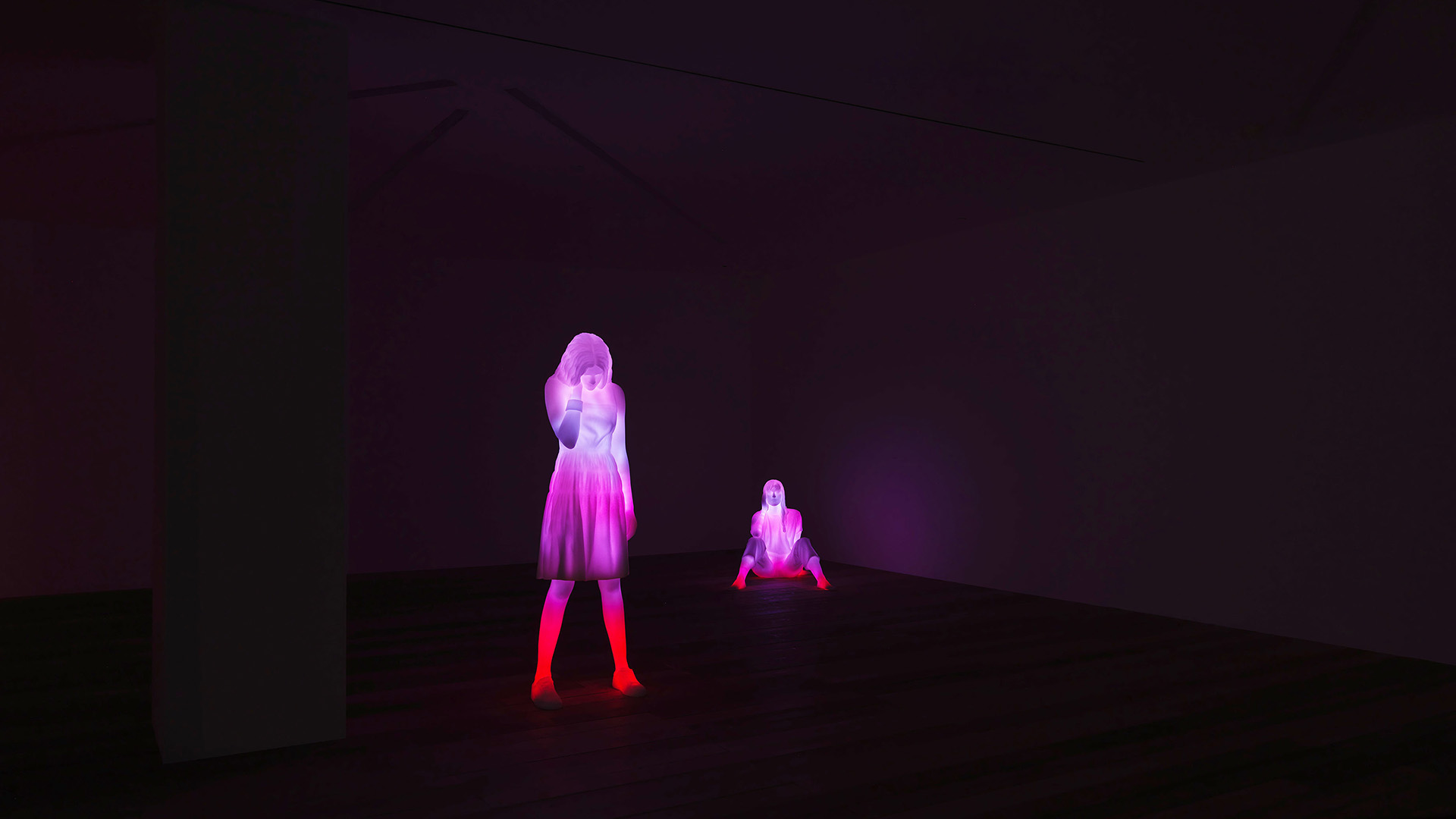Blog
Prélude Eternal: Between two realities in art
21 April 2025 Mon
Ekmel Ertan guides viewers through Borusan Contemporary’s Prélude Eternal exhibition, where art and office life seamlessly intertwine, offering a unique journey between two parallel realities.
The experience of viewing an exhibition at Borusan Contemporary is notably distinctive. On weekdays, Haunted Mansion serves as the headquarters of Borusan Holding, while on weekends, it transforms into an exhibition space. This shift in function occurs within the same physical structure, reminding me of the relationship between hardware and software.
Within this unchanged shell—the "hardware"—of an office building we encounter artworks placed within workspaces instead of the conventional white cube, which is typically stripped of external influences. As visitors, we cannot entirely escape the traces of its office function, making the experience distinct from a traditional art space. We are also aware that once the function shifts back, these artworks still exist within the rhythm of everyday life. It feels as if we are glimpsing into someone else’s world, caught in an in-between moment—a kind of deliberate disorientation.
On a weekend, we start by exploring the temporary exhibition on the second-floor gallery space before making our way upstairs. The typical approach—or at least my route—is to visit the main gallery on the second floor first, then head up to the fourth floor to see the rest of the temporary exhibition. After the temporary exhibition, I climb up to the top floor and gradually make my way down through the office floors, where the collection exhibition unfolds.
This is where the experience of viewing art shifts in the office floors. We are not in a gallery nor in a museum; we are witnessing a private art collection in a live setting. I use the word live deliberately—much like a live broadcast. And the sense of being “in between,” as mentioned earlier, is heightened at this moment, every weekend, as if we are stepping in during a broadcast break. Yet, the artworks are on air even when we are not looking—like a paradox straight out of Schrödinger’s cat experiment.
Unlike artworks displayed in isolation from the outside world, these pieces inevitably engage with their surroundings, each forming a unique and evolving relationship with the space. Some blend into the environment, taking on a decorative presence, while others expand their impact through alienation and tension.
This effect becomes even more pronounced when encountering the spatial photography artworks in the collection—many of which depict abandonment or solitude. These images simultaneously evoke a sense of estrangement and nostalgia, reinforcing the feeling of being caught between two states.
In Prélude Eternal, a current selection from the Borusan Contemporary Art Collection, Dutch photographer Ellen Kooi’s stylized artworks—where landscape and portrait photography intertwine—are particularly striking. We find ourselves gazing at solitary figures placed within nature through a theatrical composition, achieving a stunning visual harmony. Yet, between us and them, there is always a subtle reminder of office life—perhaps a desk or another detail from the workspace.
In Jose Maria Mellado’s Tequendama Falls (2008), we stand before a breathtaking natural landscape. In Edward Burtynsky’s Shipbreaking 10 (2000), however, we observe an industrial site, a workplace that has transformed into a landscape from the vantage point of an entirely different workplace.
Each of these encounters creates a temporary disconnection from our immediate surroundings, immersing us in a different spatial relationship—one that belongs to the artwork itself. The artworks exert such a strong pull that, over time, our focus shifts entirely to the artworks, rendering the physical space around us insignificant. This phenomenon underscores the significance of art’s integration into everyday life, demonstrating its significance to circulate through language, emotion, and experience.
Let’s step away from the spatial experience and return to the Prélude Eternal exhibition and the selection from the collection. The Borusan Contemporary Art Collection stands apart from many others in Turkey for several reasons, such as its focus and overall aesthetic approach. However, for me, the most defining distinction is its strong emphasis on new media art.
The collection includes significant artists and artworks that are crucial to the history of new media art. While there are a limited number of collectors in Turkey who focus on acquiring new media artworks, Borusan Contemporary stands as the only collection, to the best of my knowledge, that engages with this field from a historical perspective, acquiring works on an international scale and in a quantity that constitutes a comprehensive and significant collection.
In the Prélude Eternal selection, there are four artists and their artworks in the new media art category: Laurent Bolognini, Marina Zurkow, Alen Rath, and U-Ram Choe. These artists and their artworks differ greatly in character, which reflects the nature of new media art itself. The term 'new media' inherently indicates this multiplicity, Bolognini's artworks could generally also fall under the light art category within the collection, but this classification can vary on a case-by-case basis. It should also be noted that many artworks can belong to multiple categories. In fact, making clear definitions and drawing boundaries in this topic as many others in art is challenging.
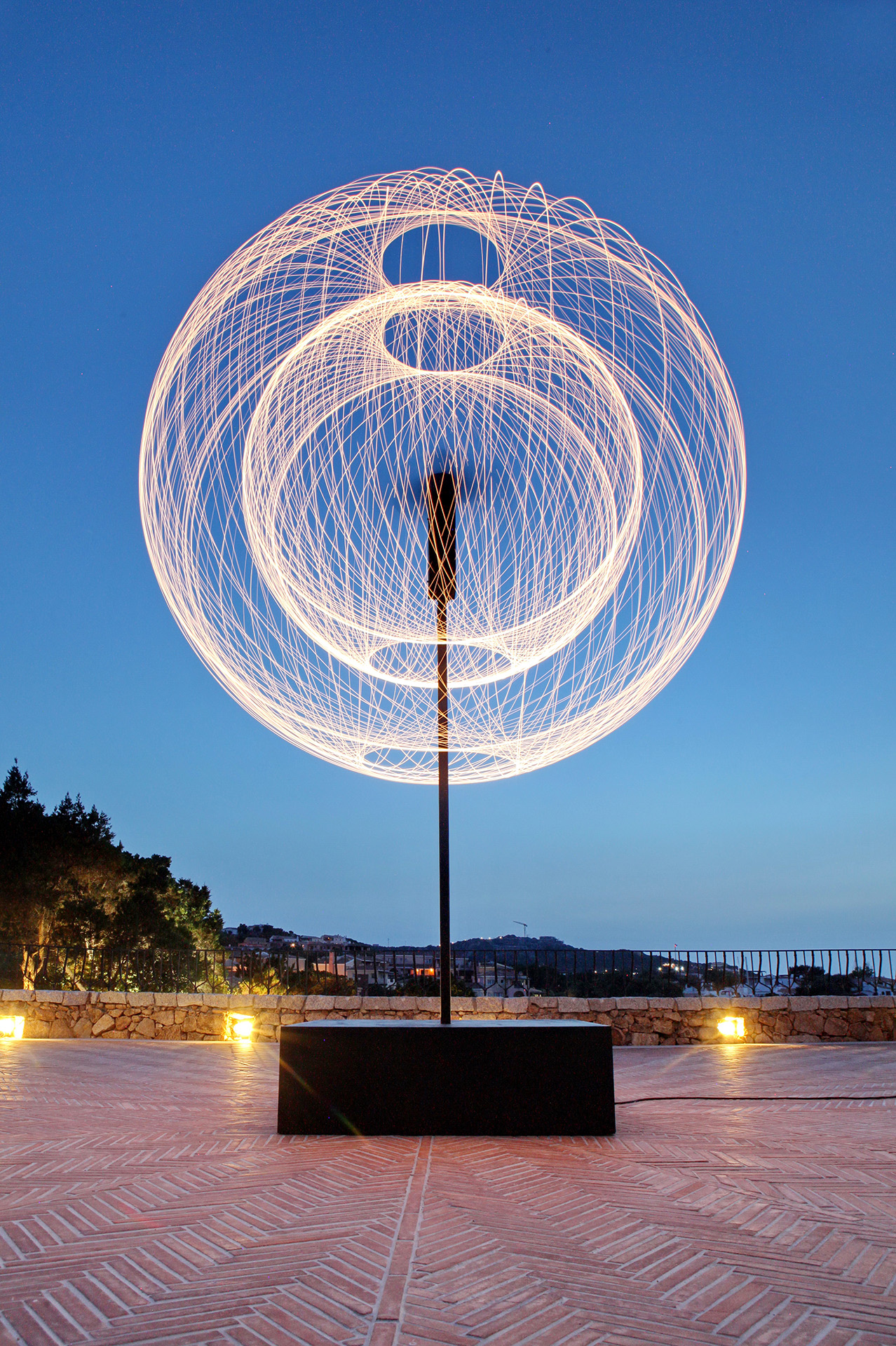
Laurent Bolognini, X-360.
Variable dimensions.
Kinetik installation, 8 led bulbs, 3 motors.
Courtesy of the Borusan Contemporary Art Collection and the artist.
Bolognini's light and kinetic sculptures are referred to as aeroglyphic sculptures, derived from the Greek words aero (air) and glyph (drawing), meaning to draw in the air. The artwork X-360, featured in the Prélude Eternal selection, is one of these. Composed of eight LED bulbs and three motors, this light and kinetic mechanism creates two interwoven spheres when activated. We are confronted with a kind of illusion; much like in cinema, the physical limits of the eye and the brain's completion function (the Gestalt principle) work together to create a sphere in the air. In fact, there is no sphere at the center; the sphere only exists if there is an observer. Moreover, it exists only if it is observed by a human; animals, insects, or other creatures are unlikely to see the sphere.
In this regard, it is also possible to describe Bolognini's art as "immaterial art". Of course, the mechanical structure, bulbs, and motors are present, but the spheres do not exist. In other words, what we perceive as the artwork actually does not exist. Is this then related to virtual reality, another concept in new media art? Conceptually, yes, what we are seeing is virtual, but terminologically, it is not virtual reality. By virtual reality (VR), we refer to an interactive image or images within a digitally created universe. This term is directly associated with the artistic applications of VR technologies. We could describe Bolognini's sphere as virtual, but we cannot call it virtual reality art, which is a branch of new media art. Of course, it is not necessary for Bolognini or X-360 to be classified as new media simply because it is virtual reality; I raised this point to explore and unpack the concept of new media art further. However, for other reasons, I categorize Bolognini more under the category of light art, and even relate it to kinetic art and Op Art. Additionally, personally, I believe that new media art has its own set of issues, and I do not categorize purely abstract or decorative artworks under this genre.
At this point, it would be meaningful to move on to Marina Zurkow, whose artwork Mesocosm (Northumberland, England)(2011) is featured in the exhibition. This is because Marina Zurkow can be considered a new media artist. We can say that, but we need not necessarily say it. This is because, in contemporary art, we generally do not define artists by their medium: both because the medium has become less important and has receded behind the narrative, and because many mediums have come together in ways that make it impossible to categorize them under one label.
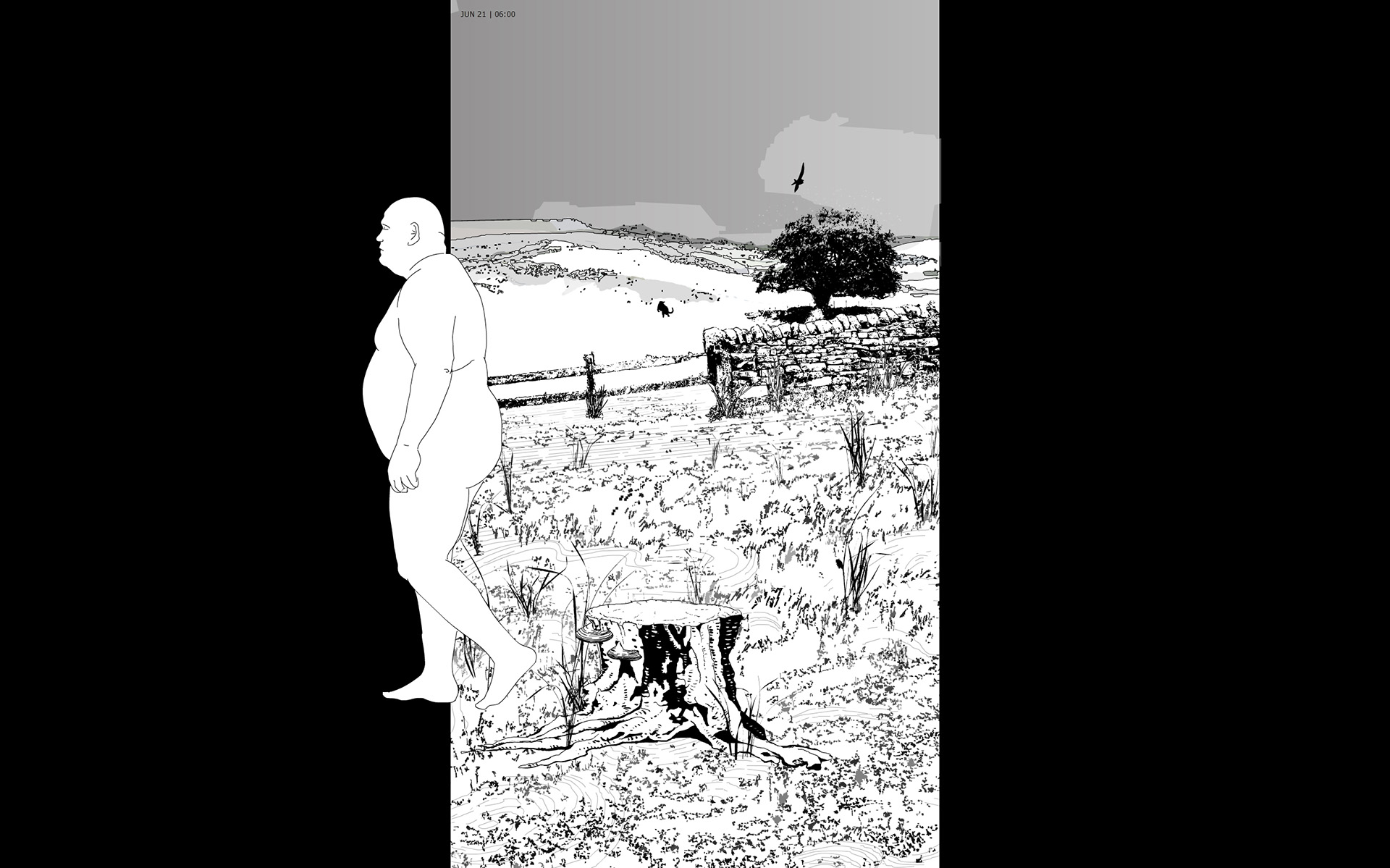
Marina Zurkow, Mesocosm (Northumberland UK), 2011.
Software-driven single-channel animation, color, sound.
Courtesy of the Borusan Contemporary Art Collection, the artist and Bitforms Gallery, NY.
Mesocosm is a series of animations, three of which (Northumberland, England; Times Square, New York; Wink, TX) are part of the Borusan Contemporary Art Collection. Mesocosm (Northumberland, England), featured in the Prélude Eternal selection, represents the northeastern part of England, known for its natural beauty and cultural heritage, and is one of the least densely populated regions in the country, bordering Scotland. The animation lasts for 146 hours, representing one year, with climate and natural movements inspired by visual features and references from the region. Each hour is represented by one minute in the animation, with seasons, day and night, movements of birds and animals, rain, snow, and other natural events, changing algorithmically. No scene is repeated. This is not a fixed 146-hour video; rather, it is a program in which events occur sequentially according to a specific algorithm, creating the animation. Therefore, each time it is shown, the 146-hour video plays differently.
This is precisely a new media artwork; the piece, created in 2011, reflects the characteristics of the period. It is an excellent example of how algorithms were conceived and used in art at that time and before. If Zurkow were to create a similar artwork today, she would likely use artificial intelligence algorithms. Perhaps she wouldn’t; after all, this series deals with ecosystems that change due to human intervention and emphasizes the cyclical nature of the environment, highlighting ecological concerns about climate change and species. Considering the dangerous relationship between artificial intelligence and climate change, I wondered if she would not use AI, but since she has recently created visuals with AI assistance, she might. To fully appreciate this artwork, you must experience it: watching the animation created in real time by a computer using a unique algorithm, observing the black-and-white world created by the artist’s drawings, and absorbing its narrative.
Additionally, the figure of the man, representing humanity, who enters and exits the scene, is inspired by Lucian Freud’s Naked Man, Back View (1992).
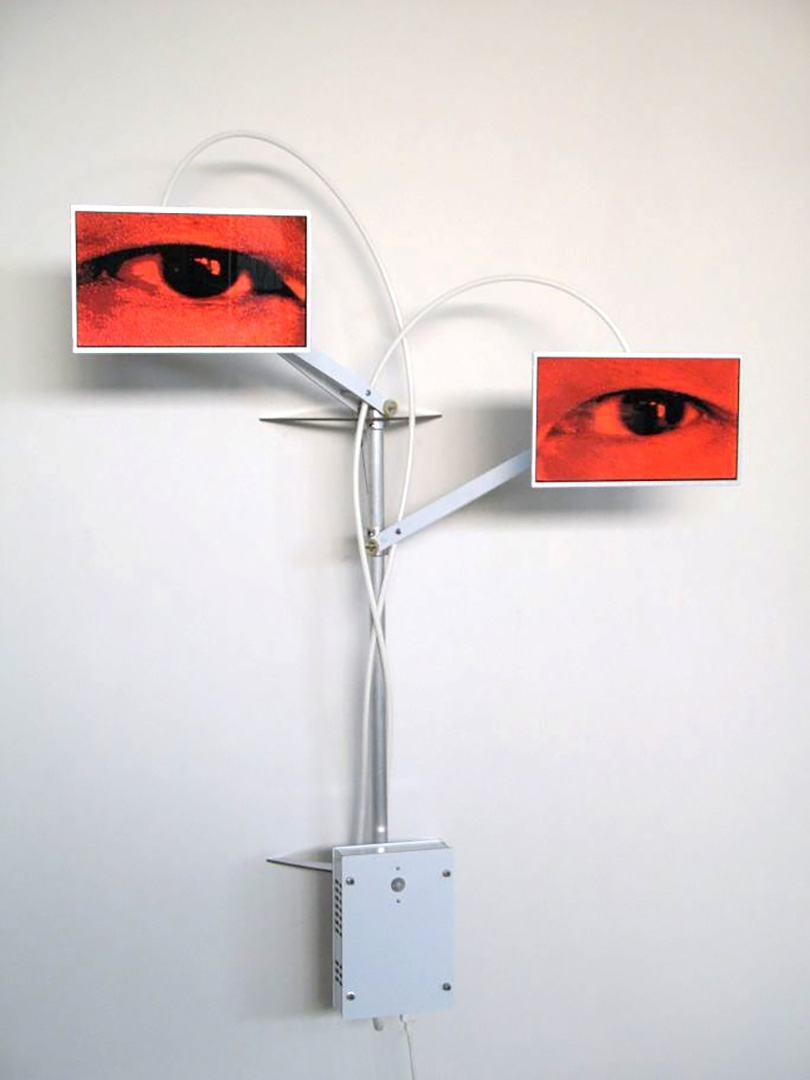
Alan Rath, Watcher VIII, 2011.
134,62 x 101,6 x 43,18 cm.
Aluminum, FR-4, polyethylene, custom electronics, LCDs.
Courtesy of the Borusan Contemporary Art Collection and the artist.
Another new media artist is Alan Rath, who passed away in 2020. Rath, from 1985 until his death, created kinetic robotic sculptures featuring parts of the human body, such as eyes, mouths, noses, and hands, which were placed on CRT or LCD screens with custom designed electronics and software. While these artworks may appear playful at first glance, they transform into strange creatures through the human body parts displayed on screens attached to mechanical extensions, forming a grotesque fusion of technology and the human body.
In Prélude Eternal, Rath's artwork Watcher VIII (2011) is displayed. The installation on the wall features two eyes that appear to be looking directly at us, blinking intermittently—sometimes in sync, sometimes not—and shifting from side to side. In one sense, they may evoke a threatening connection to surveillance society or Big Brother. However, considering Rath's artistic practice, these threatening eyes transform into strange creatures sharing the space with us. Rath's artworks, I believe, point more to a strange and paradoxical fusion, reflecting the transformation of the human body and humanity through technology, rather than posing a threat to authoritarian society. The sculptures Rath masterfully creates also evoke a cyberpunk aesthetic.
U-Ram Choe's kinetic sculptures, on the other hand, are aesthetically at the opposite end; particularly Arbor Deus Pennatus (2011), featured in this selection, appears like a piece of jewelry on the wall it is placed on. Both in form and in the elegance of the metal parts, which are stylized and inspired by nature, intricately crafted and interconnected to form the whole, a bird gently flaps its wings.
Choe creates kinetic sculptures inspired by natural forms and biology. While I mentioned that Rath’s artworks evoke a cyberpunk aesthetic, Choe’s artworks can be said to recall the aesthetics of steampunk, blending it with the Korean artist’s minimalism, attention to detail, and patience. By combining materials such as stainless steel, aluminum, brass, copper, and gold with the precision of a jeweler, Choe constructs forms where the joining details and gears conveying movement become integral elements of the aesthetic structure. With his intricate mechanisms, the artist creates magnificent kinetic sculptures. The Borusan Contemporary Art Collection also includes five more artworks by Choe, and I have admired others with the same aesthetic and mechanical perfection in previous exhibitions.
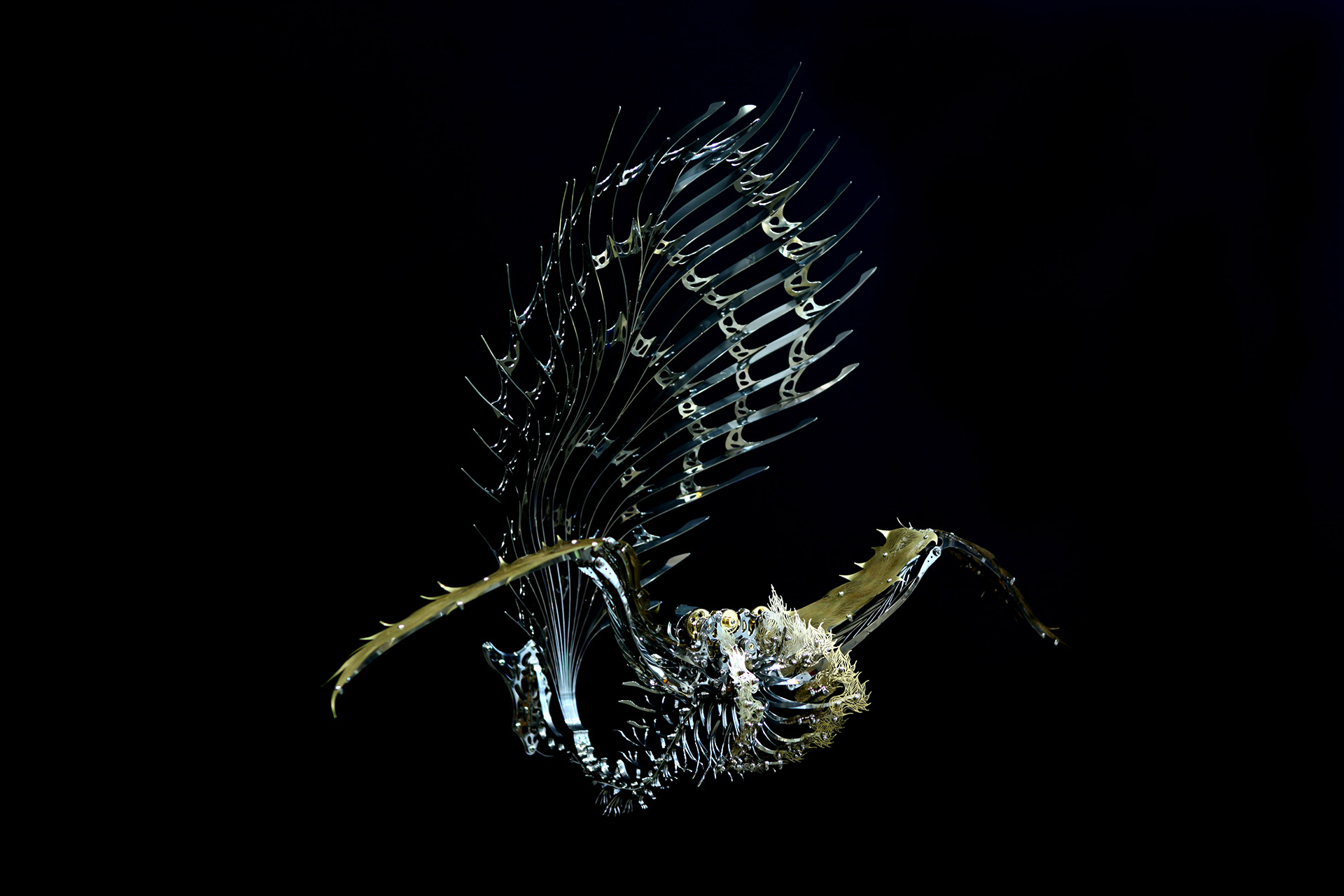
U-Ram Choe, Arbor Deus Pennatus, 2011.
79 x 112 x 46 cm. Metallic material, machinery, custom CPU.
Courtesy of the Borusan Contemporary Art Collection and the artist
Finally, another artist I associate with new media, and one I find impressive, is Martin Walde with his artwork Hallucigenia 3 (2009) in the exhibition. This piece, part of the Hallucigeniaseries, is inspired by the form of a marine creature that lived 500 million years ago and is now extinct. I remind you not to forget to gently touch the piece as you view it, leaving more for the viewer to explore.
*If you would like to learn more about the artists and their artworks, you can visit the following websites: Alan Rath, U-Ram Choe, Marina Zurkow, and Martin Walde.
ABOUT THE WRITER
Ekmel Ertan works as a curator, cultural manager, artist and educator. Ertan is the founder and artistic director of İstanbul based amberPlatform/BIS (Body-Process Arts Association), which is a research and production platform on art and new technologies. Ertan was the director of the international “amber Art and Technology Festival” in Istanbul between 2007-2015. He curates new media works as an independent curator in Turkey and abroad. Ertan has exhibited his new media installations, photography and collaborative performance works in Turkey, Europe, and The States. Since 2007, Ertan has been working as the site coordinator and director of EU supported multi-partner international projects on behalf of BIS.
Ertan received his BSc degree in Electronics / Communication Engineering from the Technical University of Istanbul and his MA degree on Interactive Media Design from Yıldız Technical University. He worked as a design and test engineer on telecommunication systems in Turkey, Germany, and Belgium. Since 1999 he has taught new media art and design at Istanbul Bilgi University, İstanbul Technical University, Sabancı University, İzmir Economy University, Berlin Internal University. Ertan lives and works in Berlin and Istanbul.


